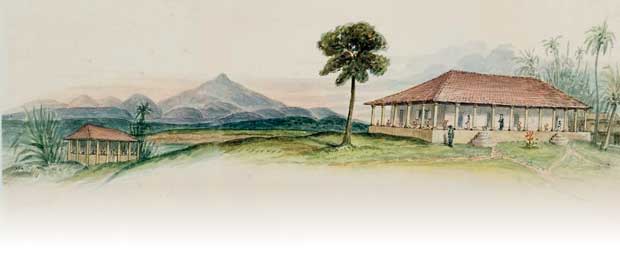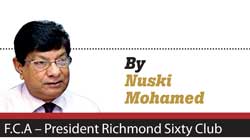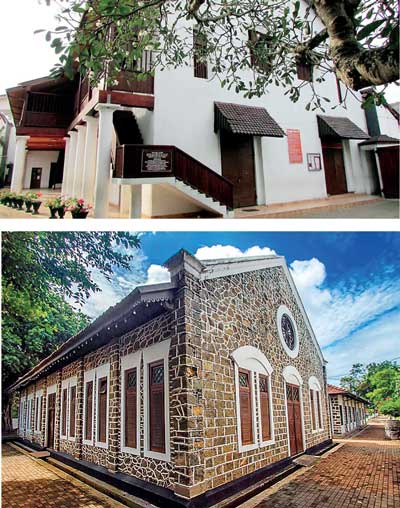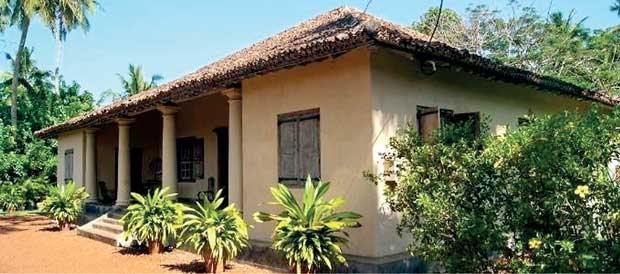Reply To:
Name - Reply Comment

 Richmond College, Galle, a premier educational institution in Sri Lanka with an unparalleled history, completes 203 years of incessant existence on 25th July 2017. Beginning as the ‘Galle School’ in 1814, it took a little more than six decades before it was renamed ‘Richmond’. During her 203-year long journey, she passed several milestones.
Richmond College, Galle, a premier educational institution in Sri Lanka with an unparalleled history, completes 203 years of incessant existence on 25th July 2017. Beginning as the ‘Galle School’ in 1814, it took a little more than six decades before it was renamed ‘Richmond’. During her 203-year long journey, she passed several milestones.
The native monarchy ended with the British subjugating the entire country in 1815. The first missionaries from England were the Baptists and from the Church of Ireland and with the presence of the Anglican Chaplains they all began to actively propagate their brands of Christianity. In 1813 six of the Missionaries of the Wesleyan Methodist Church, led by the Rev Dr Thomas Coke, set sail to Ceylon accompanied by William Ault, James Lynch, George Erskine, William Martin Harvard, and Thomas Hall Squance, Benjamin Clough and, John Mckenny, destined for Cape of Good Hope. Rev Dr Coke died at sea on the 2nd of May and was committed to the deep the next day. The other missionaries arrived in Bombay and five of them came to the Galle Harbour on 29th June 1814. The governor, General Sir Brownrigg of the country had prior knowledge of their arrival and sent his Brother-in-law the Rev Bisset, the senior Chaplain, to meet and confer with the Missionaries and to learn about their future plans and report to him. General Brownrigg on hearing of their plans suggested that they start schools to teach English to the natives’ while engaging in preaching and was promised pecuniary assistance of fifty Rix dollars (the legal currency at the time) for each school they established. The Governor made this suggestion with foresight. He foresaw the need of an educated native workforce if the country was to be developed and progressed.
A large Dutch built house in Galle was initially taken on rent, but later purchased by Erskine on behalf of the Methodist Mission, and the school was moved to Galle Fort. That building is at present the main hall of Southlands Girls’ School

The Missionaries held a meeting- the first Wesleyan Methodist ‘Conference’- on 4th July 1814 at the Queen’s House Galle, heralding the beginning of the Methodist Mission in the country. And by ballot they decided the stations for the six missionaries. William Ault was selected to labour in Batticaloa, James Lynch and Thomas Hall Squance to occupy Jaffna, George Erskine to Matara, and Benjamin Clough to remain in Galle, and William Martin Harvard, to occupy Colombo upon his arrival.
Benjamin Clough was visited by the Maha Mudaliyár of Galle, Don Abraham Dias Abeysinghe Amarasekera on 25th July 1814, on hearing that Clough was to start a school soon. He offered his deceased brother Balthazar’s vacant house for this purpose. The house was built in 1712 by the Dutch, in upper Dickson Road, Galle, and was known as Doornberg.
The Missionaries held a meeting- the first Wesleyan Methodist ‘Conference’- on 4th July 1814 at the Queen’s House Galle, heralding the beginning of the Methodist Mission in the country
Mission documents record, “Mr. Clough, after acknowledging the liberal offer of the Mudaliyár, went to view the premises, which are about a mile from the Fort, and only a stone’s-throw from the house of the generous proprietor. They are situated in a very retired and romantic spot; and appeared in most respects to be so eligible, that Mr. Clough did not hesitate to accept of the liberal proposal. He immediately had his luggage removed; and was thus, without any expense to the Mission Fund, placed at once in a situation of comfort and respectability; and in circumstances of all others the best; calculated to promote his improvement in the language, and his usefulness among the natives. His school was soon commenced, and attended by some of the most intelligent boys on the island.” The date is recorded in the Rev Clough’s journal archived in the library of the School of African-Asian Studies (SOAS), as 25th July 2014.
Colebrooke observed that the English missionary societies have formed extensive establishments in various parts of Ceylon
The school became very popular with more and more natives seeking to study under the Rev Clough. In 1815 Rev William Harvard joined his brethren in Galle. The Rev Erskine had returned to Galle by this time abandoning his school in Matara due to disinterest by the natives though it was opened with much enthusiasm. The Rev Harvard was to soon move to Colombo as planned earlier.
The Rev Erskine took over from Clough when he left for Colombo with Rev Harvard. A large Dutch built house in Galle was initially taken on rent, but later purchased by Erskine on behalf of the Methodist Mission, and the school was moved to Galle Fort. That building is at present the main hall of Southlands Girls’ School. Although no reason is adduced for the relocation in mission records it could be argued that it was due to societal reasons prevailing at the time. The Mission continued to use Doornberg for many more years and billeted the unmarried missionaries who started arriving in the country. It also served as a temporary abode for missionaries of several other denominations who arrived in Ceylon during the second decade of the nineteenth century.

In 1816, the Rev John Mckenny too arrived in Galle failing to secure permission from the Governor to establish a mission in South Africa and joined Erskine. In 1817, the Rev Mckenny established the first Wesleyan Methodist Vernacular.
The educational system took another decisive turn in 1865 with the discontinuance of The Central School Commission. The government changed its policy of giving the grant to schools based on their performance, deviating from the earlier policy of allowing grants on predetermined criteria like student population and the number of tutors
The school in Bone vista, Unawatuna, Galle, which was later abandoned, was taken over by the Anglican Church. It was called the Bone vista School. He then established the second English School of the Galle School in Ja Kotuwa, Mágálla together with a female department (in later years it went on to become the Rippon Girls’ School). It was a vernacular school and a caste based one, made at the request of the natives belonging to that caste living around Mágálla. He also established the first Anglo-vernacular school in Minuwangoda, Galle and several other schools in the suburbs. All these schools, although on different foundations, was the same Galle School.
The Methodist Mission opened more small (Limited capacity) schools in Galle, but the parent School was the Galle School in Fort. The Superintending missionary of Galle supervised the school with locally recruited teachers. It’s said that the all scholars sat together and took instructions, irrespective of caste, creed, ethnicity, religion or social standing. Richmond can take credit for being the pioneer school to eliminate caste, creed, and ethnic rivalries in schools.
In 1829, Lieutenant-Colonel William MacBean George Colebrooke and Charles Hay Cameron, in 1830, two Royal Commissioners, came to Ceylon to study and report on administrative, financial, economic, and judicial reforms. They submitted five reports between December 1831 and May 1832, and they became the reports of the “Commission of Eastern Enquiry. Colebrooke proposed drastic changes to the Civil Service and recommended that the public service should be freely open to all classes of persons according to their qualifications. He also recommended that the government implemented the proposals in 1833. He proposed that the government actively takes part in the role of education. He also proposed the establishment of a School commission to make policy decisions, on education, and supervise all schools in the country to ensure a uniform system of education.
Colebrooke observed that the English missionary societies have formed extensive establishments in various parts of Ceylon, and it would be unnecessary to retain the government schools in situations where English instructions may already be afforded. He also proposed to disallow teaching of scripture during school hours and suggested it be taught either before or after the time spent inside the classroom. The School Commission was established in 1834, but soon encountered problems due to inter-denominational rivalries on the teaching of the scripture. The School Commission was discontinued and a new Central School Commission was established in 1841. The first Methodist female School was established by the Rev William Bridgnell in 1842, which is at present known as Southlands Girls’ School. Colebrooke wanted the vernacular schools abolished, but the Methodist Mission didn’t agree to the proposition. It was after the Central School Commission in 1841 that vernacular education was encouraged again.
The Central School Commission offered a grant to all schools willing to be supervised and conducted according to the commission’s proposals. The commission formed a list of all schools who agreed to the proposition. The Galle Boys’ and the Girls’ School, giving its consent to get the grant, too was included in the list which was incorrectly interpreted by many as a government takeover. In the history of education in Sri Lanka, the government took over schools only in 1962, and not in any other year. Those schools that became eligible to the grant continued to be supervised by the respective sponsoring societies.
The Rev Joseph Rippon, who became the superintending Missionary in 1851, purchased an abandoned mountainous property in Galle known as Mount Seymour or the Sillery’s Hill in 1857. He sought permission to start a High school, an industrial school, an academic institute for females with a farm. His proposal wasn’t sanctioned, but he was asked to move several native schools, the Anglovernacular school operating in Minuwangoda and the female school in Magalle to the hill, to save the rent paid to private properties in conducting the schools. The School in the Hill was then called the Richmond Hill School and the female branch, the Richmond Hill Girl’s Boarding School.
The educational system took another decisive turn in 1865 with the discontinuance of The Central School Commission. The government changed its policy of giving the grant to schools based on their performance, deviating from the earlier policy of allowing grants on predetermined criteria like student population and the number of tutors. The schools were subject to government inspection and the grant had to be earned based on performance and the progress made. Schools had to be upgraded from their present status if they were to earn an enhanced grant. Thus, many vernacular schools were upgraded to Anglo-vernacular schools and the Anglo-vernacular schools were converted to high schools.
With his health failing, Rev Rippon returned home in 1861. Rev Nicholson came after him and pursued Rev Rippon’s dream of establishing a high school. In 1863 the Society sanctioned to upgrade the Anglo-vernacular school in the hill to a high school and renamed it as Wesley College. Unfortunately due to pressure from the Colombo elite, it was moved out from Richmond Hill, and the Dam Street School was elevated to a high school. This is the present Wesley College.
The Rev George Baugh, who was serving in Kandy, returned home in 1873 with his sick wife, who didn’t survive the voyage and died at sea. He remained in England for some time and having remarried, returned in 1874. He too pursued Rev Rippon’s dream of a high School in the hill. With Rev Baugh’s perseverance and commitment it was sanctioned in 1875. The Anglovernacular school in the hill was converted to a collegiate School by connecting the Mágálla English School. The institute was renamed as Galle High School with the Rev Samuel Langdon at the helm. Six years later, Rev Samuel Hill suggested the institute be renamed Richmond College.
Under Langdon the school became popular and made rapid progress. One year after the school was converted to a collegiate school, several Scholars gained entrance to the newly formed Ceylon Medical School in 1877, while several others were successful in sitting for the Calcutta University examination. Langdon served for three years and was transferred to Kandy.
From the beginning of Richmond as the Galle School in 1814 until it was converted to a collegiate School in 1876, the Superintending Missionary of Galle administered the school and he served as Principal.
Beginning with Rev Benjamin Clough in 1814, as many as 21 Missionaries Superintended the School until it was converted to a collegiate institution in 1876. Rev Samuel Langdon became the first Missionary Principal of the school. The school was vested in the Government in 1962 until which time the school was under the Wesleyan Methodist Mission. During this period there were seventeen Methodist Missionary and three Ceylonese Methodist Principals. The first Buddhist Principal D G Welikala was appointed in 1962. Since then the school has had ten Principals up to the present times. Of all the Principals Richmond had, seven were old boys. Claude Ivor de Silva, who took care of the school until it was taken over, is the oldest living principal now aged 94 years.
For a school to exist uninterrupted for 203 years is a great achievement. Being the oldest Wesleyan Methodist School in Sri Lanka and Asia is also a great prestige.
Several Richmond Missionary Principals left an indelible mark in the College History. Rev Samuel Langdon is credited with introducing science to schools in Sri Lanka. The Rev James Hone Darrell Memorial Hall of the college, built in 1898 by the Rev Darrell, is an engineering marvel. It has no pillars to support a high tiled roof and has withstood the test of time for more than a century. Rev W J T Small is credited with for being in the forefront with the Buddhists in the Temperance movement.
In 1876 Rev George Baugh’s unremitting efforts to convert the school in to a high school paid off. It became a High School. For many years, the misinterpretation of the transformation of the Anglo-vernacular school in Richmond Hill to a High school or a collegiate institute was taken as the beginning of the school. The Methodist Church of Sri Lanka recently made a proclamation rectifying the error.